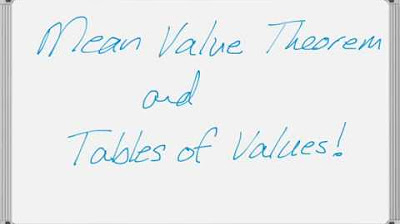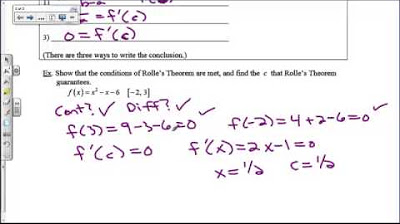AP Calculus Review Three Theorems You Must Know (EVT, IVT, MVT)
TLDRThe video script discusses three crucial theorems for the AP exam: the Extreme Value Theorem (EVT), the Intermediate Value Theorem (IVT), and the Mean Value Theorem (MVT). The EVT states that a continuous function on a closed interval must attain a maximum and minimum, emphasizing the importance of continuity over differentiability. The IVT asserts that a continuous function on a closed interval, taking on values at the endpoints, must also take on any value between those at some point within the interval. Lastly, the MVT posits that for a function that is continuous on a closed interval and differentiable on an open interval, there exists at least one point where the derivative equals the average rate of change over that interval. The video emphasizes the practical application of these theorems in solving problems and advises students to be well-versed in them for the AP exam, suggesting practice with multiple-choice and free-response questions.
Takeaways
- 📌 The Extreme Value Theorem (EVT) states that a continuous function on a closed interval attains a maximum and a minimum on that interval.
- 📌 The Intermediate Value Theorem (IVT) asserts that a continuous function on a closed interval takes every value between its endpoints at some point within the interval.
- 📌 The Mean Value Theorem (MVT) posits that for a function that is continuous on a closed interval and differentiable on the open interval, there exists at least one point where the derivative equals the average rate of change over the interval.
- 📌 Continuity is a requirement for EVT and IVT, while MVT additionally requires differentiability.
- 📌 Differentiability implies continuity, which is crucial for applying these theorems when a function is described as differentiable.
- 📌 EVT is often used as a justification in multiple-choice questions without being explicitly named.
- 📌 IVT is commonly used to prove equalities and is frequently applied in table problems and compositions.
- 📌 MVT is used to move between levels of a function, such as using the function to prove something about its derivative or vice versa.
- 📌 Rolle's Theorem is a special case of MVT where the function has the same value at the endpoints, implying the existence of a point with a derivative of zero.
- 📌 When applying MVT, it is important to state the conditions (continuity and differentiability) and show that they are met.
- 📌 Practice with a variety of problems, including multiple-choice and free-response questions, is essential for mastering these theorems for the AP exam.
Q & A
What are the three theorems discussed in the video that are likely to appear on the AP exam?
-The three theorems discussed are the Extreme Value Theorem (EVT), the Intermediate Value Theorem (IVT), and the Mean Value Theorem.
What is the Extreme Value Theorem (EVT) and what does it state?
-The Extreme Value Theorem (EVT) states that if a function is continuous on a closed interval from A to B, then the function must attain a maximum and a minimum on that interval at least once.
Why is it important to remember that differentiability implies continuity?
-It is important because often you are told a function is differentiable, and from this, you can infer that it is also continuous. This allows you to apply theorems like EVT that require continuity.
How is the Intermediate Value Theorem (IVT) applied in the context of the AP exam?
-The IVT is used to prove that a function must be equal to a certain value within a given interval if it is continuous and takes specific values at the endpoints of the interval.
What does the Mean Value Theorem state and what are the conditions required for its application?
-The Mean Value Theorem states that if a function is continuous on a closed interval and differentiable on an open interval, then there exists at least one point in the open interval where the derivative of the function equals the average rate of change over the interval. The conditions are that the function must be continuous on the closed interval and differentiable on the open interval.
How does the Mean Value Theorem allow you to move between different levels of a function?
-The Mean Value Theorem allows you to use information about the function (F) to prove things about its derivative (F'), and vice versa. It bridges the gap between different levels of the function.
What is Rolle's Theorem and how does it relate to the Mean Value Theorem?
-Rolle's Theorem is a special case of the Mean Value Theorem where the function takes the same value at the endpoints of the interval. It allows you to find a point where the derivative of the function is zero.
How can the Mean Value Theorem be used to prove that a function is increasing or decreasing on a certain interval?
-By showing that the derivative of the function (F') is positive (for increasing) or negative (for decreasing) on the interval, using the Mean Value Theorem to find a point where this condition holds.
What are some common pitfalls or misconceptions regarding the application of these theorems on the AP exam?
-Common pitfalls include assuming a function is differentiable when it is only stated to be continuous, or overlooking the fact that the Mean Value Theorem requires both continuity and differentiability on specific intervals.
Why is it recommended to practice with a variety of Free Response Questions (FRQs) when studying for the AP exam?
-Practicing with FRQs helps to solidify understanding of the theorems and their applications, as these questions often require a deep understanding and the ability to apply the theorems in different contexts.
What is the significance of the Mean Value Theorem in calculus and why is it important for students to master it?
-The Mean Value Theorem is significant because it connects the concepts of derivatives and slopes of tangent lines to the average rate of change over an interval. Mastering it is important as it is widely used in calculus to solve a variety of problems and is a key topic on the AP exam.
How can a student ensure they are correctly applying the theorems discussed in the video?
-Students should ensure they understand the conditions required for each theorem, state these conditions when applying the theorem in their work, and practice problems that test these theorems to reinforce their understanding.
Outlines
📚 Introduction to Theorems for AP Exam
The video introduces three key theorems that are crucial for the AP Calculus exam: the Extreme Value Theorem (EVT), the Intermediate Value Theorem (IVT), and the Mean Value Theorem (MVT). The presenter emphasizes that while the EVT may not be explicitly mentioned, it is fundamental for understanding and justifying solutions without naming it. The IVT and MVT are more commonly used and require continuity and differentiability, respectively. The video focuses on conceptual understanding rather than problem-solving, aiming to ensure that viewers are familiar with these theorems for the exam.
🔍 Deep Dive into Calculus Theorems
This paragraph delves deeper into the application and importance of the Mean Value Theorem (MVT) in calculus. It highlights the conditions necessary for using the MVT, which include a function being continuous on a closed interval and differentiable on an open interval. The presenter advises to always state these conditions when applying the theorem in Free Response Questions (FRQs). The MVT is used to relate the behavior of a function to its derivatives, allowing for proofs about the function's rate of change (F prime). The video also discusses strategies for using the MVT, such as finding points where the function's rate of change is zero (Rolle's Theorem), and provides examples of how the theorem might appear in multiple-choice and FRQ formats on the AP exam.
Mindmap
Keywords
💡Extreme Value Theorem (EVT)
💡Intermediate Value Theorem (IVT)
💡Mean Value Theorem (MVT)
💡Continuity
💡Differentiability
💡Rolle's Theorem
💡Slope of Secant Line
💡Free Response Questions (FRQs)
💡Multiple Choice Questions
💡Table Problems
💡Practice
Highlights
The extreme value theorem (EVT) states that if a function is continuous on a closed interval [A, B], it must attain a maximum and minimum on that interval.
EVT is the least commonly mentioned of the three theorems on the AP exam, but it's important to know as it often comes up as a justification in multiple-choice questions.
The intermediate value theorem (IVT) states that if a function is continuous on a closed interval [A, B] and takes values f(A) and f(B), it also takes any value between f(A) and f(B) at some point within the interval.
IVT is used to prove equalities, such as f(x) = 12, and is commonly used on effort cues and table problems.
Mean value theorem (MVT) states that if a function f is continuous on [a, b] and differentiable on (a, b), there exists a point c in (a, b) such that f'(c) = (f(b) - f(a)) / (b - a).
MVT is the most calculus-based of the three theorems and is used to move between levels, e.g. using f to prove things about f' and vice versa.
To use MVT, you need to verify that the function is continuous on the closed interval and differentiable on the open interval.
Rolle's theorem is a special case of MVT where f(a) = f(b), which implies that there exists a point c where f'(c) = 0.
MVT is commonly used on multiple-choice questions to find a value of c, determine the number of guaranteed c values, or show that no c value exists.
On free-response questions, MVT is frequently used to prove that a function is increasing/decreasing on an interval or to show that f' is not always positive/negative on an interval.
MVT is often used to show that f'(c) equals a specific value, which is the most common application on table problems.
It's important to practice using MVT on a variety of problem types, as it comes up frequently on the AP exam, especially on table problems.
Differentiability implies continuity, so if a function is given as differentiable, it is also continuous and the continuity-based theorems (EVT, IVT) can be applied.
When using a theorem on a multiple-choice question, be sure to check if the function is continuous or differentiable as required by the theorem.
Be cautious of multiple-choice questions that try to trick you with a function that is only continuous but not differentiable.
If a function is given as twice differentiable, it means both f and f' are continuous and differentiable on the required intervals.
When using MVT to prove a statement about f' or f'', make sure to state the continuity and differentiability conditions that you are assuming.
In summary, know the extreme value theorem, intermediate value theorem, and mean value theorem well and practice applying them on a variety of AP exam problems.
Transcripts
Browse More Related Video

Using the Mean Value Theorem with a Table of Values

Mean Value Theorem and Rolle's Theorem

The MEAN Value Theorem is Actually Very Nice

Calculus 1 Lecture 3.2: A BRIEF Discussion of Rolle's Theorem and Mean-Value Theorem.

Mean value theorem | Existence theorems | AP Calculus AB | Khan Academy

Mean Value Theorem with Example
5.0 / 5 (0 votes)
Thanks for rating: